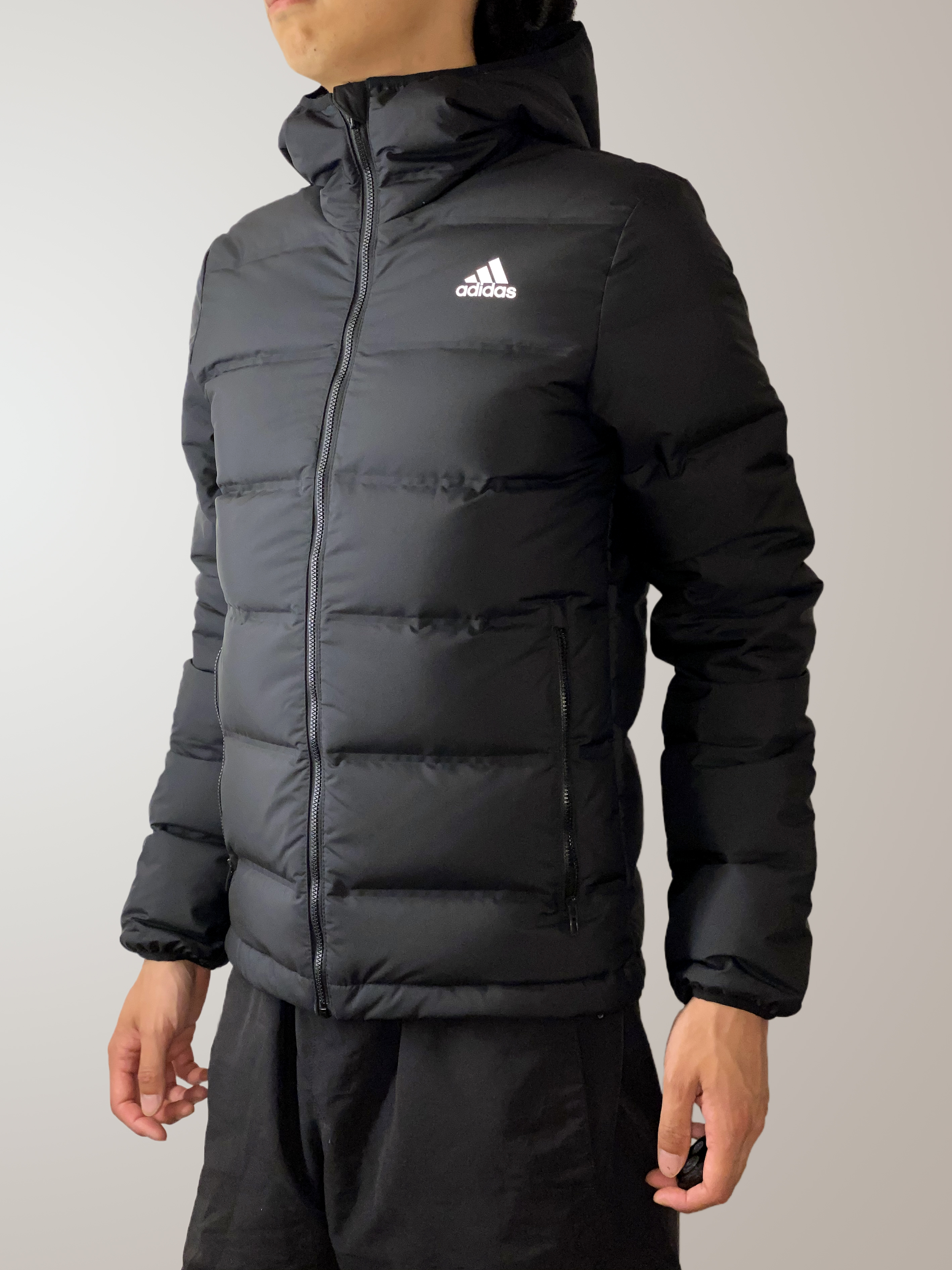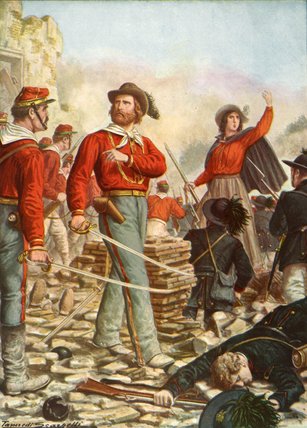|
Zouave Jacket
A Zouave jacket is a short open fronted jacket with long sleeves, similar to that historically worn by the Algerian Zouave infantry of the French Army. It was a popular women's fashion in the 19th century in the United States. Colorful, braid-trimmed Zouave jackets became fashionable in the late 1850s and remained so well into the 1860s. Although generally out of fashion after the 1860s, it became locally popular again in some parts of the country towards the end of the 19th century. See also * 1850s in fashion * Bolero jacket A shrug is a cropped, cardigan-like garment with short or long sleeves cut in one with the body, typically knitted. Generally, a shrug covers less of the body than a vest would, but it is more tailored than a shawl. Shrugs are typically worn as ... * Garibaldi shirt, another military-inspired fashion of the same era References External links * 1850s fashion 1860s fashion History of clothing (Western fashion) Jackets {{fashion-stu ... [...More Info...] [...Related Items...] OR: [Wikipedia] [Google] [Baidu] |
Zouave Godey Dec 1859
The Zouaves were a class of light infantry regiments of the French Army serving between 1830 and 1962 and linked to French North Africa; as well as some units of other countries modelled upon them. The zouaves were among the most decorated units of the French Army. It was initially intended that the zouaves would be a regiment of Berber volunteers from the Zwawa group of tribes in Algeria ("Zwawa" being the origin of the French term ''zouave'') who had gained a martial reputation fighting for local rulers under the Ottoman Empire. The regiment was to consist of 1,600 Zwawa Berbers, French non-commissioned officers and French officers. 500 Zwawa were recruited in August and September 1830. However, twelve years later, this idea was dropped. More zouave regiments were raised and the men recruited to serve in them were almost exclusively French or people of French descent born in French Algeria (pied-noirs), a policy which continued until the final dissolution of said regiments aft ... [...More Info...] [...Related Items...] OR: [Wikipedia] [Google] [Baidu] |
Jacket
A jacket is a garment for the upper body, usually extending below the hips. A jacket typically has sleeves, and fastens in the front or slightly on the side. A jacket is generally lighter, tighter-fitting, and less insulating than a coat, which is outerwear. Some jackets are fashionable, while others serve as protective clothing. Jackets without sleeves are vests. Etymology The word ''jacket'' comes from the French word ''jaquette''. The term comes from the Middle French noun ''jaquet'', which refers to a small or lightweight tunic. In Modern French, ''jaquette'' is synonymous with ''jacket''. Speakers of American English sometimes informally use the words ''jacket'' and ''coat'' interchangeably. The word is cognate with Spanish ''jaco'' and Italian ''giacca'' or ''giacchetta'', first recorded around 1350s. It is ultimately loaned from Arabic ''shakk (شكّ)'', which in turn loaned from Aramean/Assyrian and Hebrew ''shaḳḳ (שַׁקּ)''. Nylon bomber jacket, also in leat ... [...More Info...] [...Related Items...] OR: [Wikipedia] [Google] [Baidu] |
Zouave
The Zouaves were a class of light infantry regiments of the French Army serving between 1830 and 1962 and linked to French North Africa; as well as some units of other countries modelled upon them. The zouaves were among the most decorated units of the French Army. It was initially intended that the zouaves would be a regiment of Berber volunteers from the Zwawa group of tribes in Algeria ("Zwawa" being the origin of the French term '' zouave'') who had gained a martial reputation fighting for local rulers under the Ottoman Empire. The regiment was to consist of 1,600 Zwawa Berbers, French non-commissioned officers and French officers. 500 Zwawa were recruited in August and September 1830. However, twelve years later, this idea was dropped. More zouave regiments were raised and the men recruited to serve in them were almost exclusively French or people of French descent born in French Algeria (pied-noirs), a policy which continued until the final dissolution of said regiments ... [...More Info...] [...Related Items...] OR: [Wikipedia] [Google] [Baidu] |
United States
The United States of America (U.S.A. or USA), commonly known as the United States (U.S. or US) or America, is a country primarily located in North America. It consists of 50 states, a federal district, five major unincorporated territories, nine Minor Outlying Islands, and 326 Indian reservations. The United States is also in free association with three Pacific Island sovereign states: the Federated States of Micronesia, the Marshall Islands, and the Republic of Palau. It is the world's third-largest country by both land and total area. It shares land borders with Canada to its north and with Mexico to its south and has maritime borders with the Bahamas, Cuba, Russia, and other nations. With a population of over 333 million, it is the most populous country in the Americas and the third most populous in the world. The national capital of the United States is Washington, D.C. and its most populous city and principal financial center is New York City. Paleo-Americ ... [...More Info...] [...Related Items...] OR: [Wikipedia] [Google] [Baidu] |
1850s In Fashion
1850s fashion in Western and Western-influenced clothing is characterized by an increase in the width of women's skirts supported by crinolines or hoops, the mass production of sewing machines, and the beginnings of dress reform. Masculine styles began to originate more in London, while female fashions originated almost exclusively in Paris. Women's fashion Gowns In the 1850s, the domed skirts of the 1840s continued to expand. Skirts were made fuller by means of flounces (deep ruffles), usually in tiers of three, gathered tightly at the top and stiffened with horsehair braid at the bottom. Early in the decade, bodices of morning dresses featured panels over the shoulder that were gathered into a blunt point at the slightly dropped waist. These bodices generally fastened in back by means of hooks and eyes, but a new fashion for a acketbodice appeared as well, buttoned in front and worn over a chemisette. Wider bell-shaped or ''pagoda'' sleeves were worn over false und ... [...More Info...] [...Related Items...] OR: [Wikipedia] [Google] [Baidu] |
Bolero Jacket
A shrug is a cropped, cardigan-like garment with short or long sleeves cut in one with the body, typically knitted. Generally, a shrug covers less of the body than a vest would, but it is more tailored than a shawl. Shrugs are typically worn as the outermost layer of an outfit, with a full shirt, tank top, or dress beneath. A bolero jacket or bolero (pronounced or in British English and in American English) is a more formal garment of similar construction but made of stiffer fabric, essentially a short tailored jacket, inspired by the matador's chaquetilla. Like the shrug, the sides of the bolero only meet at one point. See also * Zouave jacket A Zouave jacket is a short open fronted jacket with long sleeves, similar to that historically worn by the Algerian Zouave infantry of the French Army. It was a popular women's fashion in the 19th century in the United States. Colorful, braid-tr ... References Sweaters Women's clothing {{clothing-stub ... [...More Info...] [...Related Items...] OR: [Wikipedia] [Google] [Baidu] |
Garibaldi Shirt
A Garibaldi shirt (also called "Garibaldi jacket" or "Camicia rossa") was a woman's fashion, a red wool shirt named after the Italian patriot Giuseppe Garibaldi first popularized in 1860. It was the direct ancestor of the modern women's blouse.Young, p. 355 Garibaldi's Redshirts Giuseppe Garibaldi (1807 - 1882) was an Italian folk hero, a nationalist in favor of Italian independence from Austrian domination. Garibaldi's "total sincerity and honesty, and exceptional physical courage gave him the kind of personal magnetism which made women of all classes love him, and men of all classes follow him in circumstances of acute danger."Hearder, p. 188 During the Expedition of the Thousand campaign in 1860, his volunteer followers were known as "Redshirts" (''Camicie Rosse'' in Italian) for their uniforms (or rather shirts, as they could not afford full uniforms), and it is these who inspired the fashion. The Garibaldi shirt According to a brief history of the shirt waist writ ... [...More Info...] [...Related Items...] OR: [Wikipedia] [Google] [Baidu] |
1850s Fashion
Year 185 ( CLXXXV) was a common year starting on Friday (link will display the full calendar) of the Julian calendar. At the time, it was known as the Year of the Consulship of Lascivius and Atilius (or, less frequently, year 938 ''Ab urbe condita''). The denomination 185 for this year has been used since the early medieval period, when the Anno Domini calendar era became the prevalent method in Europe for naming years. Events By place Roman Empire * Nobles of Britain demand that Emperor Commodus rescind all power given to Tigidius Perennis, who is eventually executed. * Publius Helvius Pertinax is made governor of Britain and quells a mutiny of the British Roman legions who wanted him to become emperor. The disgruntled usurpers go on to attempt to assassinate the governor. * Tigidius Perennis, his family and many others are executed for conspiring against Commodus. * Commodus drains Rome's treasury to put on gladiatorial spectacles and confiscates property to suppor ... [...More Info...] [...Related Items...] OR: [Wikipedia] [Google] [Baidu] |
1860s Fashion
Year 186 ( CLXXXVI) was a common year starting on Saturday (link will display the full calendar) of the Julian calendar. At the time, it was known as the Year of the Consulship of Aurelius and Glabrio (or, less frequently, year 939 ''Ab urbe condita''). The denomination 186 for this year has been used since the early medieval period, when the Anno Domini calendar era became the prevalent method in Europe for naming years. Events By place Roman Empire * Peasants in Gaul stage an anti-tax uprising under Maternus. * Roman governor Pertinax escapes an assassination attempt, by British usurpers. New Zealand * The Hatepe volcanic eruption extends Lake Taupō and makes skies red across the world. However, recent radiocarbon dating by R. Sparks has put the date at 233 AD ± 13 (95% confidence). Births * Ma Liang, Chinese official of the Shu Han state (d. 222) Deaths * April 21 – Apollonius the Apologist, Christian martyr * Bian Zhang, Chinese official and gener ... [...More Info...] [...Related Items...] OR: [Wikipedia] [Google] [Baidu] |
History Of Clothing (Western Fashion)
The study of the history of clothing and textiles traces the development, use, and availability of clothing and textiles over human history. Clothing and textiles reflect the materials and technologies available in different civilizations at different times. The variety and distribution of clothing and textiles within a society reveal social customs and culture. The wearing of clothing is exclusively a human characteristic and is a feature of most human societies. There has always been some disagreement among scientists on when humans began wearing clothes, but studies involving the evolution of body lice suggest it started sometime around 170,000 years ago. Anthropologists believe that animal skins and vegetation were adapted into coverings as protection from cold, heat, and rain, especially as humans migrated to new climates. Textile history is almost as old as human civilization, and as time has passed, the history of textile has been more enriched. Silk weaving was introd ... [...More Info...] [...Related Items...] OR: [Wikipedia] [Google] [Baidu] |




.jpg)

